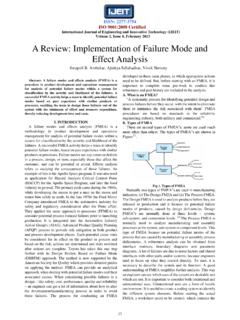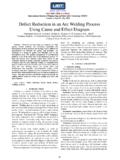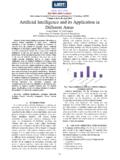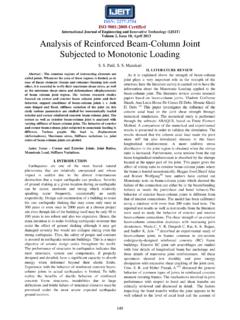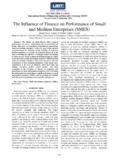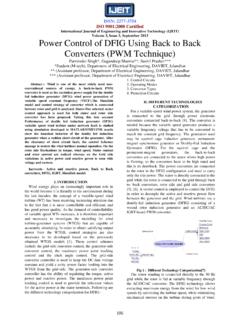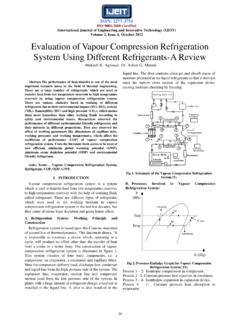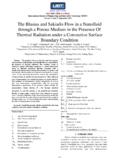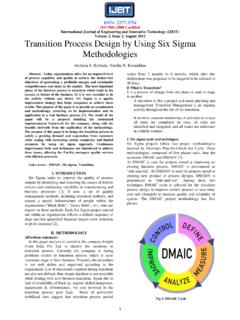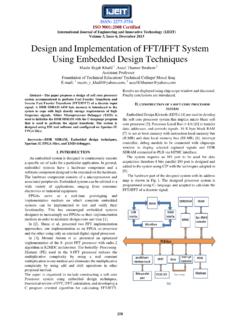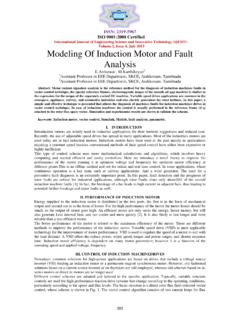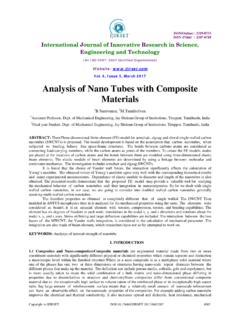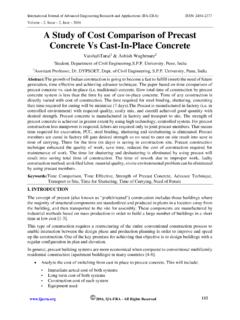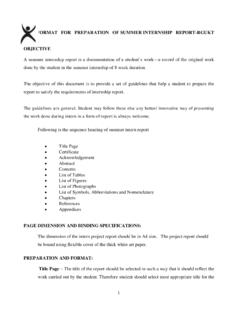Transcription of Volume 2, Issue 10, April 2013 Improvement of Wear ...
1 ISSN: 2277-3754 ISO 9001:2008 certified international journal of engineering and innovative technology (IJEIT) Volume 2, Issue 10, April 2013 54 Improvement of Wear Resistance in Engine Cylinder Liners Using Gas Nitriding Rao, chandra, Abstract- The project is aimed at improving the wear resistance of the cylinder liner which is used in internal combustion engine and many other nitriding process has been used for fullfillment of project study has been conducted to observe the change in hardness before and after gas nitriding of cylinder liners which inturn impact on wear resistance of cylinder liners.
2 Index terms :Nitriding,Gas nitriding,Cylinder liner, Wear resistance, Hardness, Internal combustion engine. I. INTRODUCTION In today's automotive field cylinder liners plays a crucial role because they are integrated part of engine cylinder liner is exposed to high temperatures while operating with in the internal combustion engine. During the reciprocating motion of the piston, the piston will come in contact with the inner surface of the cylinder liner. Hence properties such as hardness and wear resistance of cylinder liner plays a crucial role in determining efficient functioning of the cylinder and wear resistance properties can be improved by using techniques such as carburizing, nitriding etc.
3 II. HISTORY In the early years of the 20th century, Adolph Machlet recognized that the surface hardening technique of carburizing led to distortion problems due to extended periods at elevated temperatures, followed by severe quenching into either water or experimentation, Machlet soon discovered that nitrogen was very soluble in iron. Nitrogen diffusion produced a relatively hard surface in simple plain irons or low-alloy steels and significantly improved corrosion resistance. In Germany, a parallel research program was under way headed by Fry in 1906.
4 Like Machlet, Fry recognized that nitrogen was very soluble in iron at an elevated temperature. He also recognized very early in his work that alloying elements strongly influenced metallurgical and performance results. He used a technique similar to that of Machlet, where the nitrogen source had to be cracked by heat to liberate nitrogen for reaction and Machlet, Fry used ammonia as the source gas, but he did not use hydrogen as a dilutant gas. Thus was developed the single-stage gas nitriding process as it is known then investigated the effects of alloying elements on surface discovered that the nitriding process produced a high surface hardness only on steels containing chromium, molybdenum, aluminum,vanadium, and tungsten, all of which form what are known as stable nitrides.
5 III. NITRIDING Nitrding is a thermochemical process in which the surface of the ferrous metal is added with nitrogen inorder to improve wear resistance of the components. The diffusion process is based on the soloubility of nitrogen in iron. As nitriding is one of the important surface hardening technique this was being used in the manufacturing of aircraft, bearings, textile machinery and automotive components manufacturing such as valves, camshafts and piston rods etc. IV. WHY NITRIDING Nitriding process does not require a phase change steel remains in the same ferrite phase during the complete process.
6 While in the traditional process there will be a phase change from ferrite to austentite and austentite to free cooling takes place in the nitriding process quenching is not improves the fatigue life, provides anti-galling properties and high surface hardness. Nitriding process takes place comparitively at low temperatures when compared to other case hardening techniques and it is also cost effective. V. TYPES OF NITRIDING Gas nitriding Salt bath nitriding Plasma nitriding NITRIDING Gas nitriding is a type of nitriding in which the nitriding surface to be formed on the surface of the component by using the nitrogen obtained from the diffusion of process will take place inside a furnace by maintaining the required schematic diagram of gas nitriding will be as follows: The chemical reactions that takes place during the process of gas nitriding will be as follows: 2NH3 N2 + 3H2 ISSN: 2277-3754 ISO 9001.
7 2008 certified international journal of engineering and innovative technology (IJEIT) Volume 2, Issue 10, April 2013 55 The ammonia gas is provided to the furnace in which the cylinder liner is being nitrided will undergo the above reaction at the temperatures of 5000 c to 6500 c maintained in the furnace which will result in the dissociation of ammonia resulting in nascent nascent nitrogen will react with the ferric content of the cylinder liner forming a white layer on the surface of the cylinder liner due to formation of Fe3N and Fe4N. The process is carried out as two distinct events.
8 The first portion of the cycle is accomplished as a normal nitriding cycle at a temperature of about 500 C (930 F) with 15 to 30% dissociation of the ammonia ( , an atmosphere that contains 70 to 85% ammonia). This will produce the nitrogen-rich compound at the surface. Once the cycle is complete, the furnace temperature is increased to approximately 560 C (1030 F), with gas dissociation increased to 75 to 85% ( , an atmosphere that contains 15 to 25% ammonia). The two-stage process is used to reduce formation of the compound zone only. There are some process parameters involved in the gas nitriding process which need to be observed inorder to produce a nitride layer on cylinder liner as per the requirements.
9 Process parameters for gas nitriding include: Furnace temperature Time Gas flow Gas activity control Process chamber maintenance The process control factors are those elements that will ensure a controlled process and acceptable results: The total surface area of cylinder liner to be nitrided. Process pressure to be maintained inside the sealed process chamber. Gas delivery pressure system into the sealed process chamber in the furnace. Exhaust gas system from the sealed process chamber. Control of the preheat treatment procedure prior to nitriding, including stress relief and prehardening and tempering.
10 Quality and integrity of the steel surface precleaning prior to nitriding. Consistent steel chemistry. The cylinder liner that to be nitrided should not undergo quenching or any other heat treatment process which may result in phase change. The cylinder liner should be completely washed by an aqeous alkaline detergent or an should be completely cleaned to avoid all types of contaminants so that there will be no effect on nitriding layer. By taking all the prerequisites into consideration , by using the process parameters and process control factors we will perform the process of nitriding on the cylinder liners.
